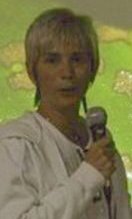Arthrosaura is a genus of spectacled lizards in the family Gymnophthalmidae.

Coral snakes are a large group of elapid snakes that can be divided into two distinct groups, the Old World coral snakes and New World coral snakes. There are 27 species of Old World coral snakes, in three genera, and 83 recognized species of New World coral snakes, in two genera. Genetic studies have found that the most basal lineages have origins in Asia, suggesting that the group originated in the Old World. While new world species of both genera are venomous, their bites are seldom lethal; only two confirmed fatalities have been documented in the past 100 years from the genus Micrurus. Meanwhile, snakes of the genus Micruroides have never caused a medically significant bite.

Micrurus is a genus of venomous coral snakes of the family Elapidae.

Tepuihyla, commonly known as Amazon tree frogs or Tepui tree frogs, is a genus of frogs in the family Hylidae found in mountains of eastern and south-eastern Venezuela and Guyana, and likely in adjacent Brazil. A tepui is a table-top mountain characteristic of the Guiana Highlands.

Stefania is a genus of frogs in the family Hemiphractidae. They are native to the highlands of the Guiana Shield in southern Venezuela, Guyana, and adjacent far northern Brazil. Most are restricted to the tepui highlands, but S. evansi also occurs in lowlands. On most mountains there are only 1–2 species from this genus, but five are known from Mount Ayanganna and the neighbouring Mount Wokomung has six species. They are usually found near streams at low levels on branches/leaves or on the ground among vegetation/rocks.

Erythrolamprus is a genus of colubrid snakes native to Central America, the Caribbean, and South America. They include the false coral snakes, which appear to be coral snake mimics.
Metaphryniscus is a monotypic genus of toads in the family Bufonidae. The sole species is Metaphryniscus sosae. The species, and thereby the whole genus, is endemic to Venezuela and only known from its type locality, Cerro Marahuaca. Its natural habitat is subtropical or tropical moist montane forests.

Typhlophis is a monotypic genus created for the blind snake species, Typhlophis squamosus, found along the Atlantic coast of South America from the Guianas to Pará in Brazil, as well as in Trinidad. No subspecies are currently recognized.

Atractus is a genus of colubrid ground snakes in the subfamily Dipsadinae. The genus includes more than 140 distinct species.

Dipsadinae is a large subfamily of colubroid snakes, sometimes referred to as a family (Dipsadidae). Species of the subfamily Dipsadinae are found in most of the Americas, including the West Indies, and are most diverse in South America. There are more than 700 member species.

Josefa Celsa Señaris is a Venezuelan herpetologist. She has published information about frogs and she has identified new genera and species. Señaris is the director of the La Salle Foundation's Natural History Museum in Caracas.

Thamnodynastes is a genus of snakes of the family Colubridae.

Dryophylax hypoconia is a species of snake in the family Colubridae. The species is endemic to South America.
Ernest Edward Williams was an American herpetologist. He coined the term ecomorph based on his research on anoles.
Dryophylax ceibae is a species of snake in the family Colubridae. The species is endemic to Venezuela.
Dryophylax chimanta is a species of snake in the family Colubridae. The species is endemic to Venezuela and only known from the Chimantá tepui.
Dryophylax dixoni is a species of snake in the family Colubridae. The species is endemic to Venezuela and Colombia.
Dryophylax nattereri, the Amazon coastal house snake or northern coastal house snake, is a species of snake in the family Colubridae.

Dryophylax paraguanae is a species of snake in the family Colubridae. The species is endemic to Venezuela and Colombia.
Dryophylax yavi is a species of snake in the family Colubridae. The species is endemic to Venezuela.












